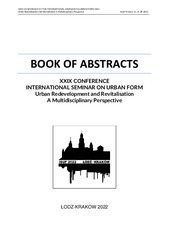| dc.creator | Niković, Ana | |
| dc.creator | Manić, Božidar | |
| dc.date.accessioned | 2024-04-15T09:45:52Z | |
| dc.date.available | 2024-04-15T09:45:52Z | |
| dc.date.issued | 2022 | |
| dc.identifier.isbn | 978-83-66741-70-60 | |
| dc.identifier.uri | http://raumplan.iaus.ac.rs/handle/123456789/931 | |
| dc.description.abstract | This paper seeks to establish the relationship between the theory of urban morphology and the practice of urban conservation and urban planning. Spatial configurations of streets, blocks and other types of urban ensembles represent a heritage of a kind whether it is institutionally protected or its value is recognizable by experience or analysis. Good experiences of citizens’ living and good traditions of city planning and building are ignored in contemporary urban planning practice in Belgrade, but also other Serbian towns. There, new planning approaches are applied which are based mainly on fulfilling the economic interest of private investors. The main issue is how to protect the space, how to ensure positive effects of future transformations which are supposed to meet the complex demands of contemporary life. In considering these, the recommendation from the international charters on the protection of urban heritage as well as good planning practices and urban morphology approach are discussed. An example of a postmodernist open residential block, incorporated in the urban tissue of individual housing, has been analyzed in terms of spatial and functional features of the block, procedures of planning, the content of planning documents, and its implementation. The recent transformations have been discussed that have been unfolded within a new planning framework and are mainly characterized as partial interventions which neglect the context and the initial plans which once have been developed for the whole block. Urban morphology can help in analyzing space qualities, creating scenarios for future development, and controlling planned transformations. The way of introducing the urban morphology approach depends on the capacity of the institutional and legal framework and it calls upon introducing new procedural instruments and steps: commission for check physical/morphological dimension of plans, handbooks for assessment the qualities of the location, etc. | sr |
| dc.language.iso | en | sr |
| dc.publisher | Łódź : Łódź University of Technology | sr |
| dc.relation | info:eu-repo/grantAgreement/MESTD/inst-2020/200006/RS// | sr |
| dc.rights | openAccess | sr |
| dc.source | XXIX Conference International Seminar on Urban Form. Urban Redevelopment and Revitalisation. A Multidisciplinary Perspective, 6-11 September 2022, Łódź – Kraków, Łódź: Łódź University of Technology, Book of Abstracts | sr |
| dc.title | Urban form, plans and procedures: some recent transformations of Belgrade’s urban tissue | sr |
| dc.type | conferenceObject | sr |
| dc.rights.license | ARR | sr |
| dc.citation.spage | 147 | |
| dc.citation.rank | M34 | |
| dc.description.other | Editors: Anna Agata Kantarek, Małgorzata Hanzl, Tomasz Figlus, Łukasz Musiaka. | sr |
| dc.identifier.fulltext | http://raumplan.iaus.ac.rs/bitstream/id/3809/Book of abstracts_AN.pdf | |
| dc.identifier.rcub | https://hdl.handle.net/21.15107/rcub_raumplan_931 | |
| dc.type.version | publishedVersion | sr |

